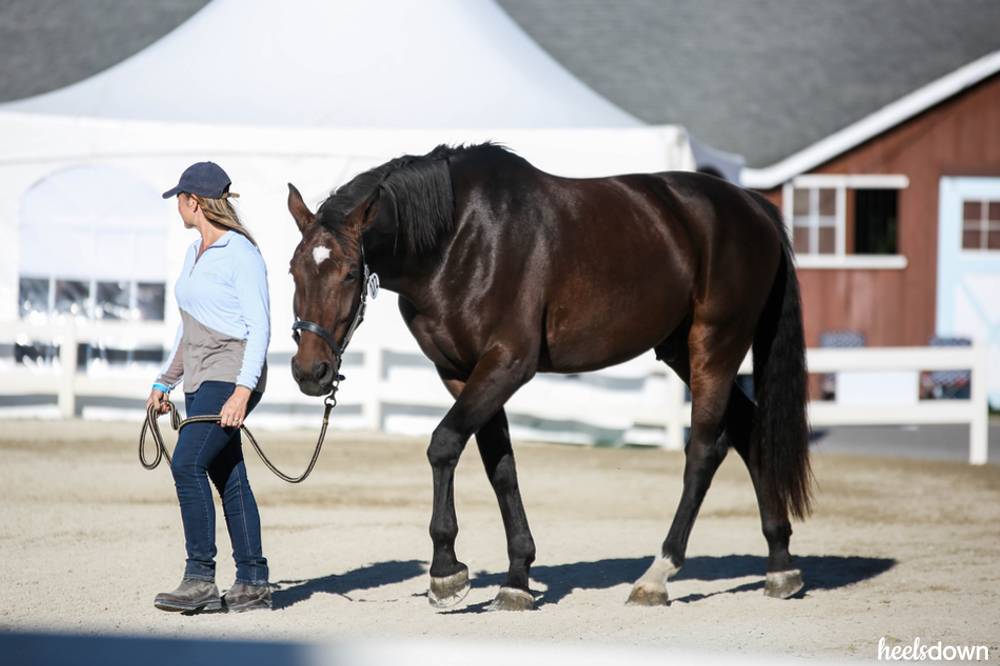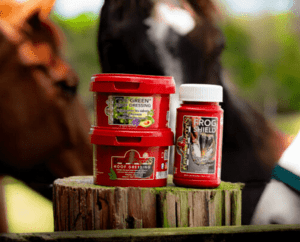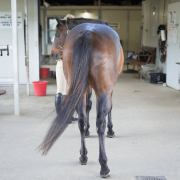Kissing Spines: Surgical Options for a Long-Term Fix

In part one of this series, we covered the multi-faceted process of diagnosing kissing spines properly in horses with back pain. In this second and final installment, we’re discussing the surgical options for long-term treatment.
Your veterinarian has noted discomfort in your horse’s back both under saddle and moving freely around the field. He’s also looked at your horse’s back through different types of imaging like radiograph, thermography, and bone scan. He may have performed a nerve block to temporarily alleviate the back pain and has considered your horse’s history. Ultimately, your veterinarian has arrived at the diagnosis of kissing spines.
What’s next?
In horses with true kissing spines, where the bony spinous processes in his back are impinging or overriding on each other, surgery may be the best long-term approach.
“If kissing spines is truly what’s going on, surgery is your best option,” says Dr. Kenneth Marcella, an equine veterinarian who owns KLM Equine in Canton, Ga., and has been practicing equine veterinary medicine for 35 years. “If you’ve gotten to the point where you have a horse with major pain and disobedience – kicking out, refusing to go forward – the topical stuff won’t work for you long-term, because you’re not going to change the spine.”
While steroid injections, massage, chiropractic care, and other less-invasive treatment options are a good starting point, they will only treat the pain but not the anatomical root of the problem, explains Dr. Marcella. This means that without surgery, you may be left repeating these treatments for years to come.
Surgical Option 1: Ligament Transection
There are two surgical procedures used in equine medicine today to treat kissing spines. Both involve modifications to the horse’s spine, so they provide a more permanent solution to the problem while alleviating pain as well.
The first procedure, called interspinous ligament desmotomy, is relatively straightforward and can be done under sedation and local anesthesia, as Dr. John Peroni, a veterinarian, researcher and board-certified large animal surgeon at the University of Georgia explains. He performs this surgery several times a year and says that when the area is completely numbed, the horses typically tolerate it very well. It roughly takes just 40 minutes to complete.
“The horse exerts a tremendous amount of force on its spine while exercising.”
“The goal of the surgery is to transect the ligament that lives between the spinous processes,” Dr. Peroni said.
Severing the ligament between those bony protrusions on the horse’s spine (the spinous processes) provides relief because it physically allows the bones to separate.
“The horse exerts a tremendous amount of force on its spine while exercising, so it’s presumed that the flexion and extension of the back will, in the absence of the ligaments, allow those (spinous processes) to kind of slowly separate if the transection is done correctly and completely,” he explained.
While this is not a “nerving” procedure, there is typically a lot of nerve pain relief by cutting the ligament (and any scar tissue that may have formed around it) since there are several nerves within the ligament responsible for detecting bone pain.
It’s a relatively short and easy recovery, too, Dr. Peroni said. Since the horse isn’t placed under general anesthesia, he can typically go home the following day and only needs about two weeks off from work. A saddle shouldn’t be placed on the horse’s back for six weeks, however, to allow the small incision on the back to heal fully. This procedure can range in cost from about $800-1,200, generally.
Surgical Option 2: Bone Transection
Sometimes kissing spines can be so severe that this procedure is not even possible.
“The transection of the ligament is only effective when you can get a knife and the blade system that we use between those spinous processes,” Dr. Peroni said. “To imagine it, if you were to put your hands together and there was some space between your hands, you need to have an amount of space that accommodates an instrument. If your hands are overlapping and there’s no space between them, there’s absolutely no way you can get that done.”
If this is the case, there’s a second more invasive surgery that can be performed instead.
“In those cases, the only way you can disengage the spinous processes is to transect the bone,” said Dr. Peroni. “You literally have to remove a piece of bone. Actually from an execution standpoint it’s not that big of a deal. It really isn’t that challenging but the owner has to understand it’s a different tier of invasiveness.”
This surgery involves general anesthesia, which means the horse will be completely asleep for the procedure. It takes only about an hour and 15 minutes to perform, and there are X-rays taken throughout the procedure so the vet can ensure that the space created between the bones is sufficient.
Mostly due to the general anesthesia involved, the cost of this surgery is higher – around $2,500-$3,000, generally. And due to the level of invasiveness, the horse may take several weeks longer to recover once home.
Long Term Reward
“Very few people that have the horse that falls in the category of impingement and are candidates for the first surgery choose not to go on with it, because financially it’s not that big of a commitment and the recovery is pretty quick,” Dr. Peroni explained. “And generally speaking, the outcomes are really, really good. Even in the literature, we have satisfactory outcomes that range between 70-80 percent, so to me, it’s a no-brainer.”
And while the bone transection is more invasive, it’s still recommended over not treating at all.
“The other surgery is absolutely not a devastating, last-resort option. I’ve had nothing but good luck with the surgery and I have easily 18-25 clients that I’ve done this for over the years and I’d say they’re all really impressed with the outcomes,” Dr. Peroni said.
Having a successful outcome mostly depends on how appropriate of a candidate the horse is for the procedure.
“A surgery is only going to be as successful as the case selection,” he said. “You have to do your homework. It’s just vital to find a veterinarian that can go through the diagnostic process and make sure that this is indeed (the problem) and that it needs to be addressed.”


